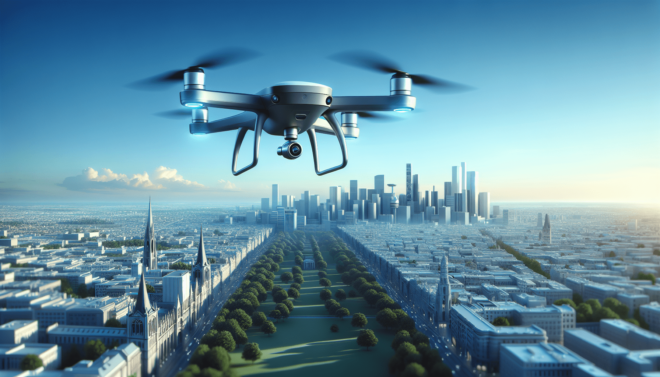What comes to your mind when you think of drones buzzing over a cityscape like Las Vegas? Is it the captivating imagery they can capture or the potential for delivering goods swiftly across the city? While drones offer an impressive array of possibilities, especially in urban areas bustling with activity, their usage is not without limitations. In this discussion, we explore why drone usage near Las Vegas’ medical centers is restricted and delve into the reasons behind these regulations.
Understanding Drone Usage Regulations
Regulations regarding drone operations are a topic of ongoing conversations and legal considerations globally, particularly in densely populated areas like Las Vegas.
Federal Regulations
The Federal Aviation Administration (FAA) governs the use of drones, officially referred to as unmanned aircraft systems (UAS). These regulations are designed to ensure the safety of the national airspace. Under federal rules, drones are prohibited from flying over groups of people, in close proximity to airports, or in areas where emergency operations are underway.
State and Local Regulations
While federal rules set the groundwork, state and local governments have introduced further restrictions tailored to the unique needs and concerns of their communities. This localized approach allows for greater control over privacy issues and public safety in specific areas, such as medical centers.
The Role of No-Fly Zones
Designated no-fly zones are an essential part of drone regulation. Such areas are identified based on safety, security, and privacy concerns. Medical facilities often fall under this category due to the sensitivity and importance of their operations.
Why Focus on Medical Centers?
Medical centers play a critical role in ensuring community health and safety. The restrictions on drone usage near these facilities are not arbitrary but rather are carefully considered based on several key factors.
Privacy of Patients
The confidentiality of patient information is a top priority in healthcare settings. Drones flying near medical centers could inadvertently capture footage of patients or staff, leading to significant privacy violations. Such breaches could have legal repercussions and undermine patient trust in healthcare institutions.
Air Ambulance Operations
Medical emergencies often require quick and efficient responses, including the use of air ambulances. Drones in the airspace near a medical center could interfere with these critical operations, causing delays or accidents. Ensuring clear airspace for helicopters is essential to maintaining a robust emergency response system.
Security Concerns
Hospitals and medical centers often house sensitive materials and information. Drones could potentially be used for malicious surveillance, aiding in espionage or theft. Restricting drone usage in these areas helps mitigate security threats and protect sensitive operations.
The Impact of Drone Restrictions on Innovation
While restrictions might seem limiting, they also serve as a catalyst for innovation in drone technology and management.
Developing Better Drone Technology
Companies are continuously working to develop drones equipped with advanced navigation systems and collision avoidance technologies. These advancements aim to ensure drones can safely operate in complex environments while respecting airspace regulations.
Enhanced Traffic Management Systems
Efforts are underway to develop sophisticated air traffic management systems for drones, which could allow for more controlled and safe integration into urban environments like Las Vegas. These systems aim to harmonize drone operations with existing air traffic regulations and infrastructure.
Drones and Urban Planning
Drone integration with urban planning is a hot topic, with potential implications for cities like Las Vegas.
Collaborative Planning
Urban planners are increasingly considering drone technology when developing new infrastructure projects. Collaborating with tech companies and government bodies could result in smart city designs that seamlessly integrate drone operations without compromising safety.
Emergency Response Improvements
By carefully integrating drones into city planning, emergency services could benefit from the use of drones for reconnaissance, traffic incident analysis, and more. However, this requires a balance between innovation and regulation to ensure patient safety and infrastructure integrity.
Understanding the Local Landscape
Las Vegas’ Unique Challenges
Las Vegas presents unique challenges and opportunities due to its densely populated urban environment, sporadic tourism influxes, and varied suburban outskirts. Navigating drone regulations in such a landscape demands a careful balance of safety, privacy, and technological integration.
Community Engagement
Community engagement is crucial in developing and adapting drone regulations. Involving local residents in discussions ensures their concerns are addressed and their needs are met, promoting greater acceptance of drones in the community while adhering to necessary restrictions.
Case Studies
Examining case studies from other cities offers insight into effectively managing drone usage in sensitive areas.
Los Angeles: Balancing Safety and Innovation
Los Angeles has implemented noteworthy measures by creating precise drone corridors that avoid sensitive areas like medical centers. These corridors allow safe, regulated drone usage while ensuring public safety and privacy.
London: Utilizing Geo-Fencing Technology
London has successfully employed geo-fencing technology to automatically prevent drones from entering restricted areas. This strategy serves as a model for controlling drone usage while preventing accidental incursions into sensitive zones.
Conclusion
Drone technology is redefining the landscape of urban life, with implications that stretch from logistical advancements to emergency response enhancements. Yet, the pressing concerns of safety, privacy, and security in sensitive areas like Las Vegas’ medical centers necessitate strict regulations. By understanding these concerns and the rationale behind them, you gain a broader perspective on how drones can be safely integrated into urban life without compromising the essential services provided by medical centers.
While regulations might seem confining, they also open the door for innovation and improved integration. By collaborating on innovative solutions and continuing public dialogue, it’s possible to harness the potential of drones for the benefit of society, all the while maintaining the integrity and safety of critical infrastructure like medical centers.

